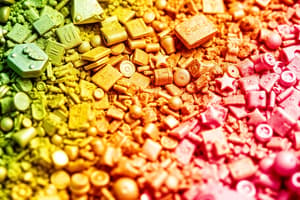Podcast
Questions and Answers
Which of the following statements about non-metals and metals is true?
Which of the following statements about non-metals and metals is true?
- Non-metals produce basic oxides in water.
- Metals typically produce basic oxides when dissolved in water. (correct)
- Non-metals do not react with oxygen.
- Most metals produce acidic oxides when dissolved in water.
Which metal is known to be a liquid at room temperature?
Which metal is known to be a liquid at room temperature?
- Mercury (correct)
- Magnesium
- Iron
- Lead
What is the main characteristic of a metal that is described as malleable?
What is the main characteristic of a metal that is described as malleable?
- It is a poor conductor of heat.
- It can be hammered or pressed into shapes without breaking. (correct)
- It has a high density.
- It can be easily stretched into wires.
When metals are burned in air, which of the following products is typically formed?
When metals are burned in air, which of the following products is typically formed?
What flame color is typically seen when magnesium burns in air?
What flame color is typically seen when magnesium burns in air?
Which of the following transformations correctly describes a chemical property of metals?
Which of the following transformations correctly describes a chemical property of metals?
Which of the following properties does not apply to metals?
Which of the following properties does not apply to metals?
How do the products formed when metals are burned in air typically behave in water?
How do the products formed when metals are burned in air typically behave in water?
Which metal reacts violently with cold water and causes the evolved hydrogen to catch fire?
Which metal reacts violently with cold water and causes the evolved hydrogen to catch fire?
Which metal is known to float when it reacts with water?
Which metal is known to float when it reacts with water?
What is produced when a metal reacts with water?
What is produced when a metal reacts with water?
Which of the following metals does NOT react with cold water?
Which of the following metals does NOT react with cold water?
Which metal's reaction with water is less violent, but still produces hydrogen?
Which metal's reaction with water is less violent, but still produces hydrogen?
What happens to magnesium when it is placed in hot water?
What happens to magnesium when it is placed in hot water?
Which metals do not react even with steam?
Which metals do not react even with steam?
In what order should metals be arranged according to their reactivity with water?
In what order should metals be arranged according to their reactivity with water?
What is the role of the anode in electrolytic refining?
What is the role of the anode in electrolytic refining?
In the process of electrolytic refining, what happens to the soluble impurities?
In the process of electrolytic refining, what happens to the soluble impurities?
Which electrolyte is used during the electrolytic refining of copper?
Which electrolyte is used during the electrolytic refining of copper?
What is anode mud?
What is anode mud?
Which of the following metals undergoes corrosion by reacting with sulphur in the air?
Which of the following metals undergoes corrosion by reacting with sulphur in the air?
During the refining process, what happens to the pure metal at the cathode?
During the refining process, what happens to the pure metal at the cathode?
What happens to copper when it reacts with moist carbon dioxide in the air?
What happens to copper when it reacts with moist carbon dioxide in the air?
Which of the following is true about the cathode in electrolytic refining?
Which of the following is true about the cathode in electrolytic refining?
What is the composition of an alloy that is described as 22 parts of pure gold?
What is the composition of an alloy that is described as 22 parts of pure gold?
Why are brass and bronze not considered good conductors of electricity?
Why are brass and bronze not considered good conductors of electricity?
What is the primary use for solder, an alloy of lead and tin?
What is the primary use for solder, an alloy of lead and tin?
What is defined as an amalgam in metallurgy?
What is defined as an amalgam in metallurgy?
What process did ancient Indian iron workers develop to prevent rusting?
What process did ancient Indian iron workers develop to prevent rusting?
What is the height of the iron pillar near the Qutub Minar in Delhi?
What is the height of the iron pillar near the Qutub Minar in Delhi?
What weight does the iron pillar near the Qutub Minar approximately have?
What weight does the iron pillar near the Qutub Minar approximately have?
Which elements are combined to create brass?
Which elements are combined to create brass?
What is the term used to describe the shining surface of metals in their pure state?
What is the term used to describe the shining surface of metals in their pure state?
Which of the following metals is known to be soft and can be easily cut with a knife?
Which of the following metals is known to be soft and can be easily cut with a knife?
What is the primary method used to group substances based on their properties?
What is the primary method used to group substances based on their properties?
Why is it necessary to handle sodium metal with care?
Why is it necessary to handle sodium metal with care?
What is the purpose of rubbing metal samples with sandpaper in Activity 3.1?
What is the purpose of rubbing metal samples with sandpaper in Activity 3.1?
Which of the following metals is known to be hard and difficult to cut with a knife?
Which of the following metals is known to be hard and difficult to cut with a knife?
What is the purpose of striking a metal with a hammer in Activity 3.3?
What is the purpose of striking a metal with a hammer in Activity 3.3?
What is the term used to describe the ability of a metal to be shaped or molded without breaking?
What is the term used to describe the ability of a metal to be shaped or molded without breaking?
Flashcards are hidden until you start studying
Study Notes
Classification of Elements
- Elements are classified into metals and non-metals based on their physical and chemical properties.
- Understanding these classifications helps in identifying everyday uses of metals and non-metals.
Physical Properties of Metals
- Metals exhibit a shiny appearance known as metallic lustre when in pure form.
- They are generally hard, with varying degrees of hardness.
- Metals can be molded or shaped; they are described as malleable (can be hammered into sheets) and ductile (can be drawn into wires).
Reactivity of Metals
- Metals react with water, producing a metal oxide and hydrogen gas.
- Reactivity varies: for example, potassium and sodium react violently with cold water, producing heat and igniting hydrogen.
- Calcium reacts less violently with water, while magnesium does not react with cold water but does with hot water.
Electrolytic Refining
- Metals such as copper and zinc can be refined using electrolytic refining.
- Impure metal acts as the anode, while a pure metal strip acts as the cathode in an electrolyte solution.
- During the process, the pure metal from the anode dissolves and deposits on the cathode.
Corrosion
- Corrosion is the deterioration of metal due to chemical reactions, such as silver reacting with sulfide in the air or copper reacting with carbon dioxide.
- Alloys, such as brass (copper and zinc) and bronze (copper and tin), exhibit different physical properties than their constituent metals.
Historical Metallurgy Example
- The Iron Pillar of Delhi, created over 1600 years ago, showcases advanced ancient Indian metallurgy techniques that prevented rusting.
- This pillar is notable for its height (8 m) and weight (6000 kg), and it remains rust-resistant, drawing attention from scientists globally.
Key Collaborative Questions and Definitions
- Explore specific metals (liquid at room temperature, best conductor of heat, etc.) and their traits.
- Definitions:
- Mineral: A naturally occurring solid substance.
- Ore: A naturally occurring solid material from which a metal can be extracted profitably.
- Gangue: The worthless material surrounding an ore.
- Recognize that some metals occur naturally in the free state, while others need extraction processes to be obtained from their ores.
Studying That Suits You
Use AI to generate personalized quizzes and flashcards to suit your learning preferences.




